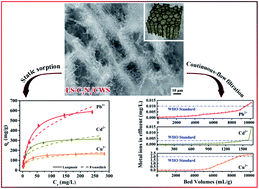Lignosulfonate functionalized g-C3N4/carbonized wood sponge for highly efficient heavy metal ion scavenging†
Abstract
Wood-based adsorbents have important engineering significance in removing toxic heavy metals from wastewater due to their natural abundance, sustainability and biodegradability together with superior sorption performance. Herein, a novel adsorbent, lignosulfonate functionalized g-C3N4/carbonized wood sponge (denoted as LS-C3N4/CWS), has been successfully fabricated through pyrolysis of urea impregnated wood sponge under an argon atmosphere, followed by subsequent modification with lignosulfonate (LS). As expected, the resulting LS-C3N4/CWS shows excellent decontamination capability toward Pb2+, Cd2+ and Cu2+ with high uptake capacities of 659.6, 329.1 and 173.5 mg g−1, respectively, outperforming most of the previously reported wood-based adsorbents and other nanomaterials. Moreover, the spent LS-C3N4/CWS can be readily recovered and maintains high removal efficiency after ten adsorption–regeneration cycles, revealing its excellent recyclability. Significantly, LS-C3N4/CWS can be directly utilized as an ultrafiltration membrane to continuously treat large volumes of simulated wastewater (9550 mL g−1 for Pb2+, 1500 mL g−1 for Cd2+ and 8700 mL g−1 for Cu2+) to below the permitted level in drinking water. The superior decontamination performance coupled with facile separation, cost-effectiveness and no secondary pollution underscores the huge potential of LS-C3N4/CWS in effectively removing heavy metals from polluted waters.



 Please wait while we load your content...
Please wait while we load your content...